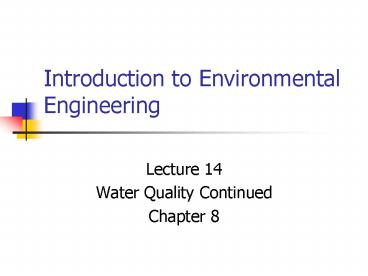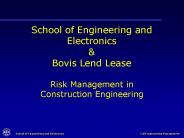Introduction to Environmental Engineering - PowerPoint PPT Presentation
1 / 13
Title:
Introduction to Environmental Engineering
Description:
Introduction to Environmental Engineering Lecture 14 Water Quality Continued Chapter 8 Solids The separation of solids is one of the primary objectives of wastewater ... – PowerPoint PPT presentation
Number of Views:115
Avg rating:3.0/5.0
Title: Introduction to Environmental Engineering
1
Introduction to Environmental Engineering
- Lecture 14
- Water Quality Continued
- Chapter 8
2
Solids
- The separation of solids is one of the primary
objectives of wastewater treatment - Solid
- Anything other than a liquid or gas
- Anything remaining after evaporation at 103 ?C
3
Solids
- Total Solids
- TS total solids, mg/L
- Wds weight of dish plus the dry solids, mg
- Wd weight of clean dish, mg
- V volume of sample, L
4
Solids
- Total Solids dissolved solids suspended
solids - Volatile Solids solids burned away _at_ 550 600
?C - FS Fixed Solids remaining ash from burning _at_
550 600 ?C
5
Nitrogen
- Remember, building blocks of life
- Carbohydrates, Protein, Fatty Acids, Nucleic
Acids - Nitrogen is a major component of Amino Acids,
which are the building blocks of protein - NH3 is an intermediate in biological metabolism
- Organic nitrogen and NH3 indicate recent
pollution Kjeldahl Nitrogen test - Nitrite and Nitrate indicate pollution some time
ago - Both are measured colorimetrically
6
Bacteriological Measurements
- Microbiology study of organisms that can not be
seen with the naked eye - Recall, before the late 1800s no one knew that
they existed. Louis Pasteur - Range in size from 1 mm to 10-5 mm
- From an environmental standpoint they are
important in every compartment, Air, Water and
Soil - Most of the organic carbon available for life is
in the form of microbes
7
Bacteriological Measurements
- It is really their world, from a population
standpoint - 1 gram of rich soil contains
- 2.5 billion bacteria
- 0.5 million fungi
- 50,000 algae
- 30,000 protozoa
8
Bacteriological Measurements
- An Environmental Engineer needs to have a
knowledge of microbes - to remove them in water treatment (filtration and
chlorination) - to support them in wastewater treatment (carbon,
nitrogen and phosphorus removal from waste)
9
Bacteriological Measurements
- Only a small fraction cause disease
- Pathogens
- Typhoid and cholera killed millions around the
turn of the century - These two waterborne diseases drove technology
advancement - Today, Salmonella, Shigella, Hepatitis,
Entamoeba, Giardia, Cryptosporidium are the main
U.S. concerns
10
Bacteriological Measurements
- Epidemiology
- The connection between pathogens in water and
human disease was made by Dr. John Snow - Father of Epidemiology
- Determined that a Cholera outbreak was from water
downstream of London - Removed the water pump, ending the outbreak
11
Bacteriological Measurements
- Indicator Organisms
- Coliforms group of microbes used to show
contamination of a source - Qualities of a good indicator organism
- Inhabits the digestive tracts of warm-blooded
animals - Plentiful
- Easily detected
- Harmless
- Survive longer than most pathogens
12
Bacteriological Measurements
- Principal Methods of Measurement
- Filter Count
- Coliforms captured on a filter
- Filter placed in agar
- Colonies grown and counted
- MPN Test
- Diluted samples placed in broth
- Gas production indicates fermentation
- Count the positive reactions, statistics
13
Assessing Water Quality
- Standard Methods for the Examination of Water
Quality (Standard Methods) - Quantitative Measurement Techniques of everything
that may be in water - Drinking Water Standards
- EPA Primary and Secondary Standards
- MCL Maximum Contaminant Level
- Wastewater Effluent Standards
- NPDES Permit National Pollution Discharge
Elimination System - Surface Water Quality Standards
- A ? E levels































